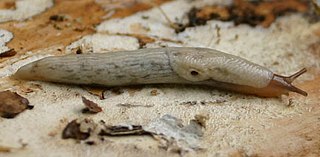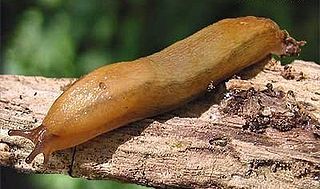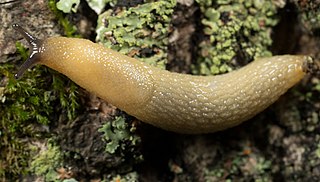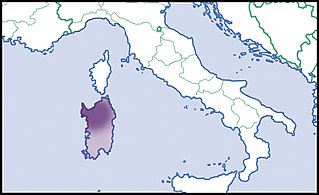
The black slug, Arion ater, is a large terrestrial gastropod mollusk in the family Arionidae, the round back slugs. Many land slugs lack external shells, having a vestigial shell. Most slugs retain a remnant of their shell, which is usually internalized, unlike other terrestrial mollusks which have external shells. Without such shells, slugs produce mucus, that may also contain toxins—to deter predators. Terrestrial slugs produce two other forms of mucus that facilitate locomotion and prevent death from drying. Such mollusks are hermaphroditic. Slugs most often function as decomposers but are also often omnivores. Arion ater is one such slug, decomposing organic matter, preying on other organisms, and consuming vegetative matter including agricultural crops. Native to Europe, the black slug is an invasive species in Australia, Canada, and the United States.

The Spanish slug is an air-breathing land slug, a terrestrial pulmonate gastropod mollusk in the family Arionidae, the roundback slugs. Other vernacular names are Lusitanian slug, Iberian slug, and killer slug.
Arion lusitanicus, also known by its common name Portuguese slug, is a species of air-breathing land slug, a terrestrial pulmonate gastropod mollusk in the family Arionidae.

Arion is a genus of air-breathing land slugs in the family Arionidae, the roundback slugs. Most species of this Palearctic genus are native to the Iberian Peninsula.

Deroceras praecox is a species of small air-breathing land slug, a terrestrial pulmonate gastropod mollusk in the family Agriolimacidae.

Arion fuscus, also known as the "dusky arion", is a species of small air-breathing land slug, a terrestrial pulmonate gastropod mollusk in the family Arionidae, the roundback slugs.

Arion distinctus is a species of air-breathing land slug in the family Arionidae, sometimes known as the roundback slugs. It is a terrestrial pulmonate gastropod mollusc. Several vernacular names exist, but it is unclear if they are much in use: brown soil slug, common garden slug, darkface arion, Mabille's orange-soled slug, April slug.

Deroceras panormitanum is a species of air-breathing land slug, a terrestrial pulmonate gastropod mollusc in the family Agriolimacidae.

Arion circumscriptus, common name brown-banded arion, is a species of air-breathing land slug, a terrestrial pulmonate gastropod mollusk in the family Arionidae. It is commonest in woodland, occurring across most of Europe, except for more southern regions, and is also widespread in North America. It has been argued that A. circumscriptus is best considered a colour morph of Arion fasciatus.

Arion intermedius is a species of land slug in the family Arionidae, the roundback slugs. It is known commonly as the hedgehog slug, hedgehog arion, or glade slug.

Arion flagellus, also known by its common name the Durham slug, is a species of air-breathing land slug, a terrestrial pulmonate gastropod mollusc in the family Arionidae, the roundback slugs.

Deroceras invadens is a species of air-breathing land slug, a terrestrial pulmonate gastropod mollusc in the family Agriolimacidae. Until 2011, this widely distributed species was known as Deroceras panormitanum, and earlier as Deroceras caruanae or Agriolimax caruanae, but Reise et al. (2011) showed that these names refer to a distinct species of similar external appearance known at that time only from Sicily and Malta. Consequently, although the more widespread species was already well known, it then had to be redescribed under the new name of D. invadens. Genetic evidence has indicated that D. invadens is native in southern Italy, including parts of Sicily, and possibly parts of central Italy. Elsewhere it has been introduced, predominantly within the last 100 years, but its spread has been constrained by cold winter temperatures.

The mating of gastropods is a vast and varied topic, because the taxonomic class Gastropoda is very large and diverse, a group comprising sea snails and sea slugs, freshwater snails and land snails and slugs. Gastropods are second only to the class Insecta in terms of total number of species. Some gastropods have separate sexes, others are hermaphroditic. Some hermaphroditic groups have simultaneous hermaphroditism, whereas some sequential hermaphroditism. In addition, numerous very different mating strategies are used within different taxa.

Ariunculus is a genus of air-breathing land slugs in the family Arionidae, the roundback slugs. Sometimes it has been considered as a subgenus of Arion, and sometimes the subgenus Ichnusarion has been raised to generic rank.

Ariunculus isselii is a species of terrestrial slug belonging to the family Arionidae. Previously it has been placed in the genus Arion or in its own genus Ichnusarion; the latter is more often treated as a subgenus.



















